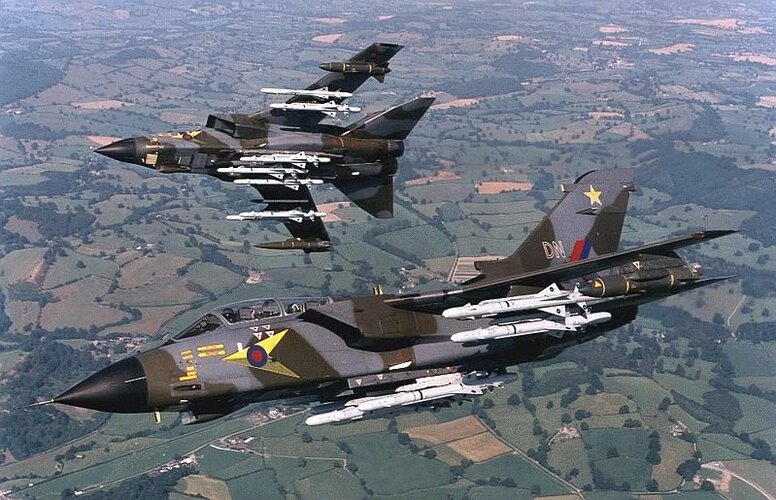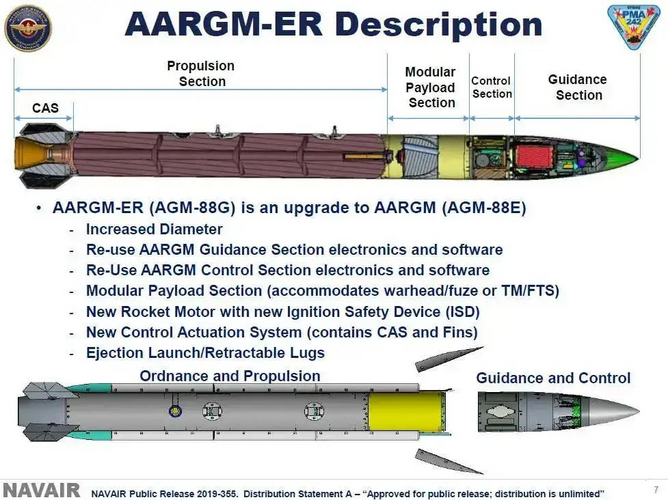totallyaverage
I really should change my personal text
- Joined
- 15 April 2018
- Messages
- 65
- Reaction score
- 145
The AGM-88D program was cancelled in 2003 and never fielded.
Just what part of those images showing the missile remains identify the missile variant?Interesting thread which is mostly speculation but interesting nonetheless:The question, which version?
The claim is that BSU-60 A/B is the part numbering for the AGM-88's "fixed tailfin assembly“.Just what part of those images showing the missile remains identify the missile variant?Interesting thread which is mostly speculation but interesting nonetheless:The question, which version?
And wouldn't a more precise way of defining missile variants be using block designations?
Did the US upgrade all its HARMs into block V and/or block VI?

- Additional high-speed, anti-radiation missiles, known as HARM missiles, for integration into Ukrainian aircraft to seek and destroy Russian radars.
First, we are providing additional High-speed Anti-Radiation Missiles. These are the HARM missiles. Ukraine has successfully employed these missiles. They have successfully integrated them onto Ukrainian aircraft, and this enables Ukraine to seek and destroy Russian radars, so we'll be providing additional HARM missiles.

possible as demonstrated by existence of R-27EP. but air-to air anti radiation missile might be on a very narrow niche.Would an air to air variant of the agm-88 high speed anti radar missile be possible?
The E variant adds the DEAD part.SEAD, that's the mission name (and not DEAD).
These were definitely techniques optimized against single digit SAMs that generally had single engagement capability, which allowed one plane or element to take the heat while the other worked over the target. The towed decoys were apparently very much a Weasel's friend.Yeah, the warhead is designed to go after the soft radar antennas - that's perfectly sufficient to mission kill, after all. The OIF tactics you describe would be too dangerous (for both sides) in Ukraine though - that's only tenable against an obsolete and severely degraded threat.
SEAD, that's the mission name (and not DEAD).
I would expect more catasthropic result tho. Heavier tungsten fragment let's say 150 grain (9.7 gr) will penetrate 0.5 inch of steel. Especially the tweet claims. "few meters". Any missiles inside the launcher would have been penetrated and may cook-off. That assumes 5 meters distance.I think the warhead is proxy fused tungsten, so it is probably heavy for its size and doesn't damage the target overly instead opting for a area effect.
SEAD is just suppression of enemy air defenseSEAD, that's the mission name (and not DEAD).
Well SEAD here include destruction of the SAM's. While DEAD is destruction of not only the SAM system but also the entire component of the air defense unit which includes command post etc.
I did vaguely remember reading from some memoir and they did mentioned that ALARMs were a lot more effective than HARM due to higher loadout and ability to loiter. Though to be fair, it probably no longer the case because modern AESA/PESA have very weak side lobes and HARM now have terminal seeker and datalinkWonder if some old ALARMs would be useful in this capacity. They had a parachute loiter model, so they could force the radars to shutdown for longer.

Only the E version does AFAIK.I did vaguely remember reading from some memoir and they did mentioned that ALARMs were a lot more effective than HARM due to higher loadout and ability to loiter. Though to be fair, it probably no longer the case because modern AESA/PESA have very weak side lobes and HARM now have terminal seeker and datalink
E and G have MMW seeker.Only the E version does AFAIK.I did vaguely remember reading from some memoir and they did mentioned that ALARMs were a lot more effective than HARM due to higher loadout and ability to loiter. Though to be fair, it probably no longer the case because modern AESA/PESA have very weak side lobes and HARM now have terminal seeker and datalink
I'm also told the E version isn't technically a HARM even though it has the AGM-88 designation, because it's made by a different manufacturer.
??? G uses an 11.5 inch motor and a completely different airframe and isn't in service yet?E and G have MMW seeker.
G version is basically very different but E version still use the same airframe and motor as basic HARMs
yeah, basically, only G version is really different??? G uses an 11.5 inch motor and isn't in service yet?E and G have MMW seeker.
G version is basically very different but E version still use the same airframe and motor as basic HARMs
I still find it shocking Ukraine has working aircraft. I had assumed (like most) that most would die first day and the survivors mopped up in a week.
This seems more plausible than adapting it to air launch from MiG-29, which would mean adding at least a precision ESM system and NATO-style launch rails.
Do you say "apparently" because you have some further info claiming they're used in prebriefed mode? Or do you say it because it's the logical way to launch them, given everything, in your personal opinion?Apparently these are being fired in Prebriefed mode, so presumably the target is set on the ground with some kind of off board electronics and the pilot has to navigate to roughly the correct launch point and the seeker does the rest if the target is illuminating.
Serbia was not being prepared for invasion though and it lasted a total of 78 days and only 3 allied aircraft and 2 helicopters were lost. Serbian aircraft were reduced to inactivity, which was sufficient.Well Serbia still have flyable MiG's TBH in 99's. as well as working air defense. Also supplies are constant.
I'm kinda feel the SEAD in 99's are somewhat forgotten.
Were Serbia air bases targeted during that war? It's been so long I don't remember. I know they were particularly well hardened from the Yugo days (I think there were armored runways, underground hangers, etc) so it might not have even been effective to attempt it.Serbia was not being prepared for invasion though and it lasted a total of 78 days and only 3 allied aircraft and 2 helicopters were lost. Serbian aircraft were reduced to inactivity, which was sufficient.Well Serbia still have flyable MiG's TBH in 99's. as well as working air defense. Also supplies are constant.
I'm kinda feel the SEAD in 99's are somewhat forgotten.
According to the Gospel of Wikipedia, 121 Serbia aircraft were destroyed. Very few of these were killed whilst airborne, so they must have mostly been destroyed on the ground.Were Serbia air bases targeted during that war? It's been so long I don't remember. I know they were particularly well hardened from the Yugo days (I think there were armored runways, underground hangers, etc) so it might not have even been effective to attempt it.
The relative failure of the air campaign to destroy SAM or other ground equipment is pretty well documented however. NATO over estimated its capability and handicapped itself in a couple of ways in an effort to avoid casualties, but also the counter measures affected by the Serbs were very effective.





